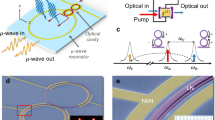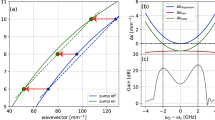Abstract
Communication using terahertz (∼1012 Hz) electromagnetic waves is critical for developing sixth-generation wireless network infrastructures. Conflictions between stable radiation and frequency modulation of terahertz sources impede the superposing of transmitting signals on carrier waves. The Josephson junctions included in a cuprate superconductor radiate terahertz waves with frequencies proportional to the bias voltages. Thus, the modulation of the bias voltage leads to the modulation of the Josephson plasma emission (JPE) frequency. This study aims to demonstrate the generation of frequency-modulated (FM) terahertz continuous waves from Josephson junctions. A FM bandwidth of up to 40 GHz was achieved when 3 GHz sinusoidal waves were superimposed on 840–890 GHz carrier waves radiated by a JPE. The results verify that the instantaneous JPE frequency follows the gigahertz-modulated bias voltage. The wide-band FM terahertz generation by a monolithic device shows a sharp contrast to the mode-lock frequency comb constructed using highly sophisticated optics on a bench. A further increase of the modulation amplitude facilitates up- or downconversion of frequencies over more than one octave. The obtained FM bandwidth exhibited an improvement of two orders of magnitude in the demodulation signal-to-noise ratio compared with the amplitude-modulated waves. The demonstrated FM JPE stimulates further research on terahertz communication technology and metrology using superconducting devices.
This is a preview of subscription content, access via your institution
Access options
Access Nature and 54 other Nature Portfolio journals
Get Nature+, our best-value online-access subscription
$29.99 / 30 days
cancel any time
Subscribe to this journal
Receive 12 print issues and online access
$209.00 per year
only $17.42 per issue
Buy this article
- Purchase on Springer Link
- Instant access to full article PDF
Prices may be subject to local taxes which are calculated during checkout






Similar content being viewed by others
Data availability
The main data supporting the findings of this study are available within this Article and its Supplementary Information. Further data are available from the corresponding author upon reasonable request.
References
Leitenstorfer, A. et al. The 2023 terahertz science and technology roadmap. J. Phys. D Appl. Phys. 56, 223001 (2023).
Shurakov, A., Lobanov, Y. & Goltsman, G. Superconducting hot-electron bolometer: from the discovery of hot-electron phenomena to practical applications. Supercond. Sci. Technol. 29, 023001 (2016).
Welp, U., Kadowaki, K. & Kleiner, R. Superconducting emitters of THz radiation. Nat. Photonics 7, 702–710 (2013).
Rappaport, T. S. et al. Wireless communications and applications above 100 GHz: opportunities and challenges for 6G and beyond. IEEE Access 7, 78729–78757 (2019).
Kumar, A. et al. Terahertz topological photonic integrated circuits for 6G and beyond: a perspective. J. Appl. Phys. 132, 140901 (2022).
Ishigaki, K. et al. Direct intensity modulation and wireless data transmission characteristics of terahertz-oscillating resonant tunnelling diodes. Electron. Lett. 48, 582–583 (2012).
Webber, J. et al. Multi‐level wireless transmission using resonant tunneling diodes in 300‐GHz band. Electron. Lett. 59, e12731 (2023).
Josephson, B. D. Possible new effects in superconductive tunnelling. Phys. Lett. 1, 251–253 (1962).
Kleiner, R., Steinmeyer, F., Kunkel, G. & Müller, P. Intrinsic Josephson effects in Bi2Sr2CaCu2O8 single crystals. Phys. Rev. Lett. 68, 2394–2397 (1992).
Yurgens, A. A. Intrinsic Josephson junctions: recent developments. Supercond. Sci. Technol. 13, R85–R100 (2000).
Ozyuzer, L. et al. Emission of coherent THz radiation from superconductors. Science 318, 1291–1293 (2007).
Kakeya, I. & Wang, H. Terahertz-wave emission from Bi2212 intrinsic Josephson junctions: a review on recent progress. Supercond. Sci. Technol. 29, 073001 (2016).
Delfanazari, K., Klemm, R. A., Joyce, H. J., Ritchie, D. A. & Kadowaki, K. Integrated, portable, tunable, and coherent terahertz sources and sensitive detectors based on layered superconductors. Proc. IEEE 108, 721–734 (2020).
Hu, X. & Lin, S.-Z. Phase dynamics in a stack of inductively coupled intrinsic Josephson junctions and terahertz electromagnetic radiation. Supercond. Sci. Technol. 23, 053001 (2010).
Koyama, T., Matsumoto, H., Machida, M. & Kadowaki, K. In-phase electrodynamics and terahertz wave emission in extended intrinsic Josephson junctions. Phys. Rev. B 79, 104522 (2009).
Koshelev, A. Alternating dynamic state self-generated by internal resonance in stacks of intrinsic Josephson junctions. Phys. Rev. B 78, 174509 (2008).
Tsujimoto, M. et al. Broadly tunable subterahertz emission from internal branches of the current–voltage characteristics of superconducting Bi2Sr2CaCu2O8+δ single crystals. Phys. Rev. Lett. 108, 107006 (2012).
Benseman, T. M. et al. Tunable terahertz emission from Bi2Sr2CaCu2O8+δ mesa devices. Phys. Rev. B 84, 064523 (2011).
Kashiwagi, T. et al. A high-Tc intrinsic Josephson junction emitter tunable from 0.5 to 2.4 terahertz. Appl. Phys. Lett. 107, 082601 (2015).
Borodianskyi, E. A. & Krasnov, V. M. Josephson emission with frequency span 1–11 THz from small Bi2Sr2CaCu2O8+δ mesa structures. Nat. Commun. 8, 1742 (2017).
Sun, H. et al. Compact high-Tc superconducting terahertz emitter with tunable frequency from 0.15 to 1 THz. Appl. Sci. 13, 3469 (2023).
Hao, L. Y. et al. Compact superconducting terahertz source operating in liquid nitrogen. Phys. Rev. Appl. 3, 024006 (2015).
Kleiner, R. et al. Space-time crystalline order of a high-critical-temperature superconductor with intrinsic Josephson junctions. Nat. Commun. 12, 6038 (2021).
Kakeya, I., Hirayama, N., Omukai, Y. & Suzuki, M. Temperature dependence of terahertz emission by an asymmetric intrinsic Josephson junction device. J. Appl. Phys. 117, 043914 (2015).
Cirillo, M., Pace, S. & Pagano, S. Frequency modulation of fluxon oscillations. Phys. Lett. A 125, 20–24 (1987).
Cassidy, M. C. et al. Demonstration of an ac Josephson junction laser. Science 355, 939–942 (2017).
Koshelets, V. P. & Shitov, S. V. Integrated superconducting receivers. Supercond. Sci. Technol. 13, R53–R69 (2000).
Uzawa, Y. et al. Superconducting receiver technologies supporting ALMA and future prospects. Radio Sci. 56, e2020RS007157 (2021).
Yamamoto, T. et al. Flux-driven Josephson parametric amplifier. Appl. Phys. Lett. 93, 042510 (2008).
Picqué, N. & Hänsch, T. W. Frequency comb spectroscopy. Nat. Photonics 13, 146–157 (2019).
Elarabi, A., Yoshioka, Y., Tsujimoto, M. & Kakeya, I. Monolithic superconducting emitter of tunable circularly polarized terahertz radiation. Phys. Rev. Appl. 8, 064034 (2017).
Asai, H. & Kawabata, S. Control of circularly polarized THz wave from intrinsic Josephson junctions by local heating. Appl. Phys. Lett. 110, 132601 (2017).
Li, M. et al. Linewidth dependence of coherent terahertz emission from Bi2Sr2CaCu2O8+δ intrinsic Josephson junction stacks in the hot-spot regime. Phys. Rev. B 86, 060505 (2012).
Tsujimoto, M., Kakeya, I., Kashiwagi, T., Minami, H. & Kadowaki, K. Cavity mode identification for coherent terahertz emission from high-Tc superconductors. Opt. Express 24, 4591–4599 (2016).
Benseman, T. M. et al. Powerful terahertz emission from Bi2Sr2CaCu2O8+δ mesa arrays. Appl. Phys. Lett. 103, 022602 (2013).
Tsujimoto, M. et al. Mutually synchronized macroscopic Josephson oscillations demonstrated by polarization analysis of superconducting terahertz emitters. Phys. Rev. Appl. 13, 051001 (2020).
Cattaneo, R., Borodianskyi, E. A., Kalenyuk, A. A. & Krasnov, V. M. Superconducting terahertz sources with 12% power efficiency. Phys. Rev. Appl. 16, L061001 (2021).
Yi, L. et al. Ultra-wideband frequency modulated continuous wave photonic radar system for three-dimensional terahertz synthetic aperture radar imaging. J. Lightwave Technol. 40, 6719–6728 (2022).
Kakeya, I., Hirayama, N., Nakagawa, T., Omukai, Y. & Suzuki, M. Temperature and current dependencies of terahertz emission from stacks of intrinsic Josephson junctions with thin electrodes revealed by a high-resolution FT-IR spectrometer. Physica C Supercond. 491, 11–15 (2013).
Burghoff, D. et al. Terahertz laser frequency combs. Nat. Photonics 8, 462–467 (2014).
Pistore, V. et al. Millimeter wave photonics with terahertz semiconductor lasers. Nat. Commun. 12, 1427 (2021).
Hiraoka, T., Inose, Y., Arikawa, T., Ito, H. & Tanaka, K. Passive mode-locking and terahertz frequency comb generation in resonant-tunneling-diode oscillator. Nat. Commun. 13, 3740 (2022).
Saito, Y., Kakeya, I. & Takano, Y. Polarization analysis of terahertz emission from Bi-2212 cross-whisker intrinsic Josephson junction devices and their refractive index. Appl. Phys. Lett. 121, 212601 (2022).
Tsujimoto, M. et al. Design and characterization of microstrip patch antennas for high-Tc superconducting terahertz emitters. Opt. Express 29, 16980 (2021).
Nomura, Y. et al. Role of the inner copper oxide plane in interlayer Josephson effects in multilayered cuprate superconductors. Phys. Rev. B 100, 144515 (2019).
Koyama, T. & Tachiki, M. I–V characteristics of Josephson-coupled layered superconductors with longitudinal plasma excitations. Phys. Rev. B 54, 16183–16191 (1996).
Machida, M., Koyama, T. & Tachiki, M. Dynamical breaking of charge neutrality in intrinsic Josephson junctions: common origin for microwave resonant absorptions and multiple-branch structures in the I–V characteristics. Phys. Rev. Lett. 83, 4618–4621 (1999).
Krasnov, V. et al. Collapse of thermal activation in moderately damped Josephson junctions. Phys. Rev. Lett. 95, 93–96 (2005).
Fenton, J. & Warburton, P. Monte Carlo simulations of thermal fluctuations in moderately damped Josephson junctions: multiple escape and retrapping, switching- and return-current distributions, and hysteresis. Phys. Rev. B 78, 054526 (2008).
Kuramoto, Y. Chemical Oscillations, Waves, and Turbulence Vol. 19 (Springer, 1984).
Mochiku, T. & Kadowaki, K. Growth and properties of Bi2Sr2(Ca,Y)Cu2O8+δ single crystals. Physica C Supercond. 235–240, 523–524 (1994).
Kashiwagi, T. et al. Geometrical full-wavelength resonance mode generating terahertz waves from a single-crystalline Bi2Sr2CaCu2O8+δ rectangular mesa. J Phys. Soc. Jpn 80, 094709 (2011).
Irimajiri, Y. et al. Development of a superconducting low-noise 3.1-THz hot electron bolometer receiver. IEEE Trans. Terahertz Sci. Technol. 5, 1154–1159 (2015).
Kashiwagi, T. et al. High temperature superconductor terahertz emitters: fundamental physics and its applications. Jpn J. Appl. Phys. 51, 010113 (2012).
Kleiner, R., Wang, H. in Fundamentals and Frontiers of the Josephson Effect Vol. 286 (ed. Tafuri, F.) 367–454 (Springer, 2019); https://doi.org/10.1007/978-3-030-20726-7_10
Acknowledgements
I.K. thanks S. Dhillon, J. Tignon, Y. Uzawa and Y. Irimajiri for discussions on terahertz spectroscopy. This work was partially conducted at University of Tsukuba and Argonne National Laboratory. G.K. and M.T. express their gratitude to Y. Kaneko for technical assistance with sample fabrication. This work was supported by the Japan Society for the Promotion of Science (JSPS) KAKENHI (grant numbers JP20H02606 (to I.K.) and JP19H02540 (to M.T.)) and ISHIZUE 2023 of Kyoto University (to I.K.).
Author information
Authors and Affiliations
Contributions
I.K. and M.T. conceived and designed the experiments. M.M., R.K. and I.K. performed the measurements, analysed and interpreted the data. M.T. and G.K. designed and fabricated the JPE device. I.K. and M.M. wrote the paper with input from R.K. and M.T. All authors participated in reviewing and revising the manuscript.
Corresponding author
Ethics declarations
Competing interests
The authors declare no competing interests.
Peer review
Peer review information
Nature Photonics thanks Kaveh Delfanazari, Vladimir Krasnov and the other, anonymous, reviewer(s) for their contribution to the peer review of this work.
Additional information
Publisher’s note Springer Nature remains neutral with regard to jurisdictional claims in published maps and institutional affiliations.
Supplementary information
Supplementary Information
Supplementary Notes 1–4 and Figs. 1–6.
Rights and permissions
Springer Nature or its licensor (e.g. a society or other partner) holds exclusive rights to this article under a publishing agreement with the author(s) or other rightsholder(s); author self-archiving of the accepted manuscript version of this article is solely governed by the terms of such publishing agreement and applicable law.
About this article
Cite this article
Miyamoto, M., Kobayashi, R., Kuwano, G. et al. Wide-band frequency modulation of a terahertz intrinsic Josephson junction emitter of a cuprate superconductor. Nat. Photon. 18, 267–275 (2024). https://doi.org/10.1038/s41566-023-01348-0
Received:
Accepted:
Published:
Issue Date:
DOI: https://doi.org/10.1038/s41566-023-01348-0
This article is cited by
-
On-chip coherent terahertz emitters with gigahertz modulation
Nature Photonics (2024)



